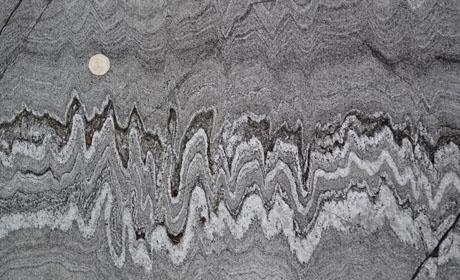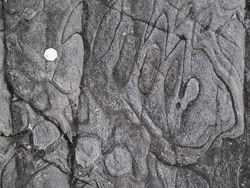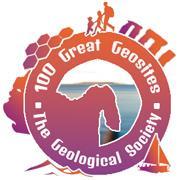Loch Monar Polyphase Folding
Inverness-shire, Scotland

Structures in the exposed roots of ancient mountain belts can display bewildering complexity. The smooth glaciated pavements around the shore of Loch Monar reservoir are excellent examples, developed in metamorphosed sandstones of the Moine rocks.

It was here in the 1950s that John Ramsay set up a framework for describing polyphase deformation through recognising patterns of multiple folding. Different shapes are formed through the interference of folds with different trends. All three end-member refolding patterns can be recognized here.
Since Ramsay’s work the challenge has been to understanding the significance of these patterns. Do they represent regional folding “events” – where entire volumes of crust deformed simultaneously by folding in a single, specific orientation? Or do these patterns have just local significance and the deformation histories that can be built up in an outcrop have no bearing on the sequence of deformation events experienced in adjacent rocks? Answers to these questions have a fundamental bearing on understanding how the continental crust deforms.
Regardless of the larger scale and generic significance, the Loch Monar outcrops can be enjoyed for the simple beauty of folded rocks.
Text: Professor Rob Butler
Further Reading
Ramsay, J.G. 1958. Superimposed folding at Loch Monar, Inverness-shire and Ross-shire. Quarterly Journal of the Geological Society 113, 271-307.- The original description – although photographs of these outcrops appear in many text books!
Read Online at the Lyell Collection (Fellows Only)
Images copyright Rob Butler

October 13 - 21
Theme: 'Earth Science in our lives'
